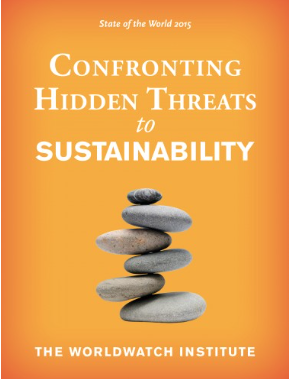Worldwatch verwacht stijging energiekosten en vreest problemen
11 juli 2015 – Op de lange termijn zullen de energieprijzen flink stijgen. Ze verhogen de kans op recessies, ongelijkheid en armoede, zo vreest het WorldWatch Institute.
 Vorige maand publiceerde WorldWatch (een mondiaal georiënteerde milieuorganisatie) zijn ‘State of the World 2015’. Het centrale thema in de editie van dit jaar is ‘the hidden threats of the rise of energy costs’. Eén van de auteurs is Nathan John Hagens (macro-ecoloog aan de Universiteit van Minnesota). Hij voorspelt ‘a period of unknown duration where things are going to be tough’.
Vorige maand publiceerde WorldWatch (een mondiaal georiënteerde milieuorganisatie) zijn ‘State of the World 2015’. Het centrale thema in de editie van dit jaar is ‘the hidden threats of the rise of energy costs’. Eén van de auteurs is Nathan John Hagens (macro-ecoloog aan de Universiteit van Minnesota). Hij voorspelt ‘a period of unknown duration where things are going to be tough’.
Uit een persbericht van WorldsWatch Institute
‘(…) The relatively low cost of energy extraction compared to the benefits obtained from fossil fuels has been perhaps the most important factor in the industrialized world’s economic success. Historically, large quantities of inexpensive fuels were available even after accounting for the energy lost to extract and process them. But, as remaining fuels become less accessible, higher energy costs will have ripple effects through economies built around continued large energy-input requirements. Rising costs will endanger highly energy-intensive industries and practices—including the energy sector itself—as well as widen and deepen poverty as everything becomes more expensive.
“Despite having ‘plenty of energy,’ higher physical costs [of extraction] suggest that energy likely will rise from a historical average of 5 percent of GDP [gross domestic product], to 10–15 percent of GDP or higher,” writes Hagens.
In the short term, nations are taking on growing debt to avoid losses in GDP—an indicator of the economic health of a country. Since 2008, the Group of Seven nations (Canada, France, Germany, Italy, Japan, the United Kingdom, and the United States) have added about $1 trillion per year in nominal GDP, but only by increasing their debt by over $18 trillion.
However, continued use of credit to mask the declining productivity of energy extraction is unsustainable. For each additional debt dollar, less and less GDP is generated, and, at the same time, our highest-energy-gain fuels are being depleted. Energy is becoming more expensive for the creditor in the future than for the debtor in the present.
“We have entered a period of unknown duration where things are going to be tough,” writes Hagens. “But humanity in the past has responded in creative, unexpected ways with new inventions and aspirations.” While policy choices such as banking reform, a carbon and consumption tax, and moving away from GDP as a proxy for well-being are good long-term ideas, “we urgently need institutions and populations to begin to prepare…for a world with the same or less each year instead of more.”
Worldwatch’s State of the World 2015 investigates hidden threats to sustainability, including economic, political, and environmental challenges that are often underreported in the media. State of the World 2015 highlights the need to develop resilience to looming shocks. (…)’
Een lezing die Nathan Hagens eerder dit jaar hield voor het WorldWatch Institute.
‘Energy, Credit and The End of Growth’, 13 april 2015 (lengte 25 min)
Bronnen
Persbericht World Watch Institute, 2 juni 2015: Energy Costs Rising as National Debts Grow
Informatie over het boek (en bestelmogelijkheid): About Confronting Hidden Threats to Sustainability



